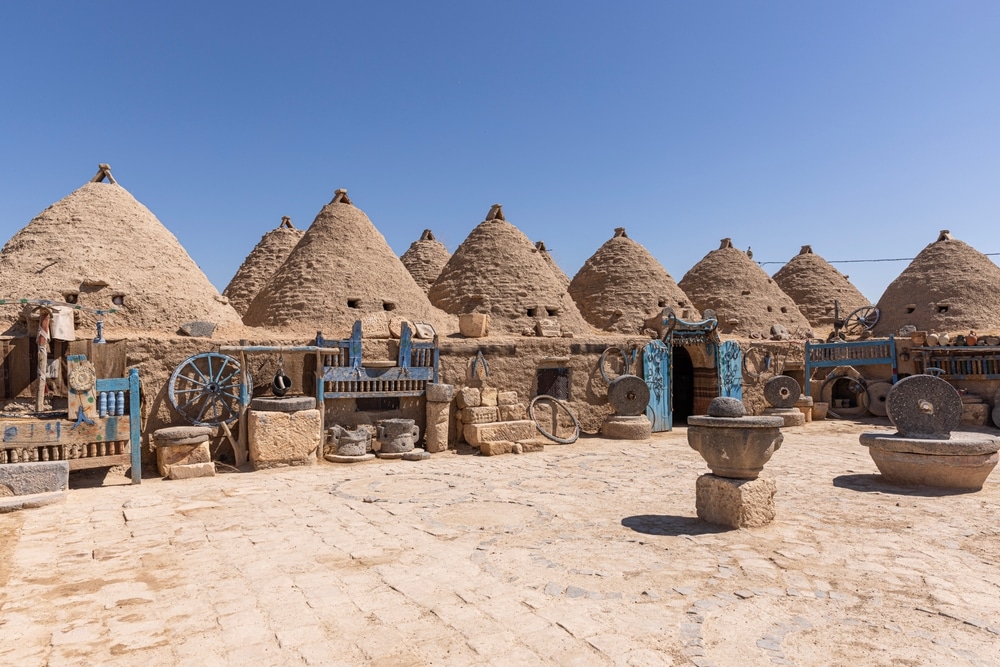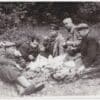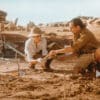Ancient Mesopotamian art and architecture are considered some of the earliest in existence, originating over 7,000 years ago. These creations emerged in northern Mesopotamia before the Ubaid Period (c. 5000-4100 BCE) and later flourished in the south during the Uruk Period (4100-2900 BCE) in Sumer, which is recognized as the first historical civilization.
Some researchers propose that the works from the Indus Valley Civilization (c. 7000 to c. 600 BCE) precede those of Mesopotamia, however, the developments in the Indus Valley did not manifest until the Early Harappan Period (c. 5500-2800 BCE), by which time Mesopotamian works were already well established. Evidence of early artistic endeavors and construction can be observed in northern Mesopotamia at locations such as Göbekli Tepe (c. 10,000 BCE) and Çatalhöyük (c. 7500 BCE), both situated in present-day Turkey, and Tell Brak (c. 6500-5000 BCE) in Syria.
This artistic journey continued through the subsequent periods; nonetheless, due to spatial constraints, the Hittite and Kassite periods will not be discussed:
- Ubaid Period – c. 5000-4100 BCE
- Uruk Period – 4100-2900 BCE
- Early Dynastic Period – 2900-2334 BCE
- Akkadian Period – 2334-2218 BCE
- Ur III Period – 2047-1750 BCE
- Old Babylonian Period – c. 2000-1600 BCE
- Hittite Period – 1700-1200 BCE
- Kassite Period – c. 1595 to c. 1155 BCE
- Assyrian Period – c. 1307-912 BCE
- Neo-Assyrian Period – 912-612 BCE
- Neo-Babylonian Period – 626-539 BCE
- Achaemenid Persian-Sassanian Persian Period – c. 550 BCE to 651 CE
Artistic creations encompassed reliefs, sculptures, metal statuary, ceramics, jewelry, cylinder seals, stelae & monuments, obelisks, and wall murals. Mesopotamian monumental architecture is encapsulated by the ziggurat, yet the Sumerians also pioneered the construction of large-scale palaces and temples, urban design, arches, canals, and aqueducts, landscaped gardens, and decorative architecture. These early advancements would undergo refinement in the region through subsequent periods and inspire the creations of other cultures across the Near East and Mediterranean areas.
Earliest Sites and Base Materials
While the Göbekli Tepe site is dated to c. 10,000 BCE, the initial permanent settlements in that region are believed to have been set up even earlier, possibly exclusively for the construction of the structure which most scholars hypothesize was a temple. Göbekli Tepe ranks among the earliest sites, alongside others such as Nevalı Çori (also situated in modern-day Turkey), featuring monumental architecture – including the oldest known megaliths globally at Göbekli Tepe – along with relief sculptures.
In architectural terms, the site consists of circular areas and rectangular buildings with T-shaped limestone pillars, some adorned with wildlife engravings in both low and high relief. There is scarce evidence of human interaction in the sculptures which appear to emphasize the natural environment and, in certain interpretations, the relationship of the people with their deities. Some scholars associate this site with the later settlement of Çatalhöyük; however, this assertion has faced challenges due to the differing designs of Göbekli Tepe and the tools discovered there in comparison to the latter site.
Regardless of its original function, Göbekli Tepe served as a communal location connected to ritual practices, while Çatalhöyük was predominantly residential. No public structures have been located at the site, which features closely packed mudbrick dwellings accessed by ladders or steps from roof openings. Artistic expressions from the location include murals and statuaries – such as the renowned Seated Woman of Çatalhöyük – alongside ceramics. The artwork seems to focus on nature and the theme of fertility, as several pieces exhibit female figures and erect phalluses.
The inhabitants of Çatalhöyük utilized clay, limestone, marble, and various other materials for their sculptures and paints derived from natural sources. The figurines, sculptures, and murals are predominantly viewed as representations of religious ideas, yet this interpretation is not universally agreed upon. There is an absence of urban planning at this site; it appears to have developed organically with structures adjoined to one another, and people using roofs for social functions and movement since there are no roads, courtyards, or public squares.
Ubaid and Uruk Periods
The inhabitants of the area surrounding Çatalhöyük are believed to have moved southward concurrently, or prior, to the unidentified groups (possibly the Sumerians) from the mountains who made their way down to the Mesopotamian plains around c. 5000 BCE. The art from the Ubaid Period is primarily distinguished by ceramics decorated with circular bands of paint and zigzag motifs as well as animal representations. Other creations include statuary – such as the well-known ‘lizard people’ figurines – and stamp seals which, as per some scholars, were the earliest version of the cylinder seal.
Among the most recognized stamp seals is the one unearthed in the remnants of the ancient Sumerian city of Girsu, illustrating a human figure with arms extended toward an animal on each side. This design, currently referred to as the ‘Master of the Animals’ (or ‘Mistress of the Animals’), is believed to be connected to the idea of deities imposing order through animal husbandry, controlling the wild fauna. This theme has been discovered in artworks across the Near East, including Egypt, as well as in Mediterranean civilizations such as Greece and Rome.
Ubaid architecture is akin to that of Çatalhöyük with rectangular dwellings constructed from mudbrick or reeds, yet the inhabitants of this period were responsible for erecting their initial public edifices, which included temples. According to contemporary scholars, these structures exhibited an early style of arch inspired by the construction techniques of reed houses. Bundles of reeds were arched over to create roofs for homes, potentially suggesting a similar form for doorways in buildings made from mudbrick, thus resulting in the first archways.
It is believed the Ubaid Period populace also constructed the earliest ziggurats; however, this monumental construction was more fully realized during the Uruk Period. The architectural style of the Uruk Period appears comparable to the site of Tell Brak concerning building methods and urban design. Throughout the Uruk Period, the initial cities emerged, with Eridu being regarded as the first by the Sumerians, noted as the locale where the deities instituted kingship and structured civilization.
During this time, palaces, temples, industrial venues, public structures, and affluent housing were primarily built of mudbrick, whereas lower-class residences utilized reeds. Most cities were encircled by walls complete with watchtowers, and the presence of arches is evident in the architecture of both these defenses and buildings. The walls and constructions were composed of rounded mudbrick, either baked in ovens or sun-dried.
Art derived from this epoch, which additionally saw the advent of writing around 3500 BCE, encompasses cylinder seals, ceramics, sculptures, decorative tablets, reliefs, and amulets. Notable artworks include the Mask of Warka and the Warka Vase, both discovered in the remnants of Uruk and attributed to the goddess Inanna. These creations were fashioned from clay, alabaster, quartz, or other stones, continuing the theme of the ‘Master of the Animals’ in some instances, while others distinctly portray tales related to the gods, nature, or both. Additionally, statues of nobility in the form of the priest-king emerged during this time, often with remarkable detail.
Early Dynastic and Akkadian Periods
During the Uruk Period, canals and aqueducts were constructed, and as previously mentioned, cities began to flourish alongside their grand ziggurats. These advancements expanded and became more prevalent during the Early Dynastic Period when kingship and priesthood separated into distinct areas of responsibility. Writing, which had been refined around 3200 BCE, became a subject taught in the scribal schools established throughout Sumer and beyond. Art and architecture thrived during this period along with various crafts. Artists—whether architects, poets, sculptors, or other craftsmen—produced some of the most notable works of that era. Scholar Stephen Bertman observes:
While this assertion generally stands, the identities of several artists are known, marked in their works or mentioned by subsequent scribes, and the roles of an artist and artisan were usually regarded with high respect. The creations of the Early Dynastic Period exceeded previous achievements in both quality and quantity as trade within ancient Mesopotamia flourished and the city-states thrived.
Among the most celebrated pieces from this period are the Standard of Ur, the Stele of the Vultures, the Ram in a Thicket, the headdress of Queen Puabi (circa 2600 BCE), and the other valuables unearthed from her grave in the ruins of Ur, including the Queen’s Lyre adorned with a Bull’s Head. The Standard of Ur showcases scenes of Mesopotamian warfare on one side and peace on the opposite through three registers (horizontal bands of figures narrating a tale) on each side—a technique previously employed on the Warka Vase. The image of the king appears larger than those around him, emphasizing his status, a method that would continue to signify gods and kings throughout Mesopotamian history.
This theme is used effectively throughout the Akkadian Period and, most significantly, in the Victory Stele of Naram-Sin (reign 2261-2224 BCE), one of the most renowned artworks from this timeframe. The stele illustrates the larger-than-life ruler climbing a mountain while he tramples the corpses of his vanquished foes. This same motif is observed in other Akkadian art, such as the Victory Stele of Rimush (reign 2279-2271 BCE), who was Naram-Sin’s uncle. Among the other notable Akkadian artifacts is the Bronze Head of the Akkadian Monarch, interpreted by some academics as a representation of Sargon of Akkad (Sargon the Great, reign 2334-2279 BCE), the founder of the Akkadian Empire. The head is believed to have once belonged to a life-size statue and exemplifies a hollow-cast figure created by pouring a substance, in this instance bronze, into a mold. This method of casting is referenced in literature, including the text Sargon and Ur-Zababa.
Ur III and Early Babylonian Periods
By the era of the Ur III Period, palatial and temple complexes had developed into fully structured edifices adorned with sculptures carved from stone or employing the same alloy-casting technique. The architectural style of the palace evolved during the Akkadian Period, and by Ur III, it reached its complete form, as noted by Bertman:
Ur-Nammu (reign 2047-2030 BCE), the inaugural ruler of the Third Dynasty of Ur, would have presided from a palace laid out as described, as he commissioned numerous building ventures embellished with gardens and adjoining orchards. His son and successor, Shulgi of Ur (reign 2029-1982 BCE), continued and augmented his policies, constructing roads, establishing educational institutions, and initiating the first roadside inns with landscaped gardens. Shulgi also completed the Great Ziggurat of Ur, which was commissioned by his father, alongside other constructions, and ensured his accomplishments were immortalized through written and artistic forms.
Shulgi, along with his father, is represented in sculptures referred to as foundation figures, crafted in copper, typically standing about a foot tall, which were embedded into the foundations of a palace or a temple to honor the king who ordered it or the deity it was raised to venerate. Votive figures, which initially emerged during the Early Dynastic Period, were refined in the Ur III. These were anthropomorphic forms of assorted dimensions with large eyes (occasionally known as the ‘eternal gaze’) positioned in a prayerful manner. Wealthy patrons commissioned these figures, intended to stand within the temple and pay respect to the deity while the patron attended to their own affairs. Thus, the patron was understood to be in perpetual communion with the divine, as each piece was believed to have been fashioned in their likeness.
Among the most renowned creations from this era are the numerous statues of Gudea of Lagash (reign 2080-2060 BCE), perpetually depicted in a prayerful, contemplative pose in line with his standing as a devout monarch associated particularly with the worship of Nisaba, the goddess of writing. Reliefs from this period, whether high or low relief, adhered to the established format of portraying a ruler or deity as larger than the others present in the artwork, and this same convention was utilized in the production of cylinder seals.
Even artistic expressions – and architectural designs – not explicitly referencing a deity were still influenced by faith-based beliefs. The king was perceived as a steward whose power ultimately derived from the gods, thus the statues and reliefs portraying monarchs maintained a religious connotation. During the Old Babylonian Period, however, this message became more defined, particularly under Hammurabi of Babylon (reign 1792-1750 BCE). The stele of the Code of Hammurabi (his legal statutes) illustrates the king receiving his mandate from Shamash, the deity of the sun and justice, and reliefs from this timeframe also distinctly portray Marduk, Babylon’s patron god, asserting his supremacy over earthly matters.
The Sumerian deities had, by this stage, been supplanted by Babylonian gods (for example, Nabu taking the place of Nisaba as the patron deity of writing), yet the same paradigm persisted with different gods responsible for various life facets. In the Early Dynastic and Ur III epochs, the brother deities Kabta and Mushdamma presided over architecture, bricks, foundations, building, and constructions, requiring offerings to be made to them prior to the commencement of a project, while at completion, prayers of thanks were directed to Arazu, the god of completed undertakings.
If one neglected to honor these deities in the appropriate manner, it was believed the construction would be cursed with misfortune. Throughout the Old Babylonian Period, this belief remained strong, and the practice continued, as illustrated by the Laws of Hammurabi, merely the titles of the deities had altered. Constructors who employed inferior materials (implying they had failed to respect the gods) that led to the failure of a residence or structure faced the death penalty.
Image Source: Mehmet Cetin / Shutterstock

































